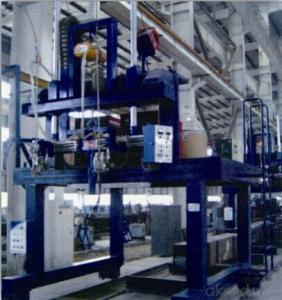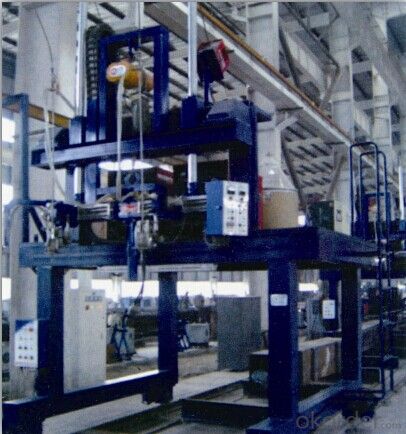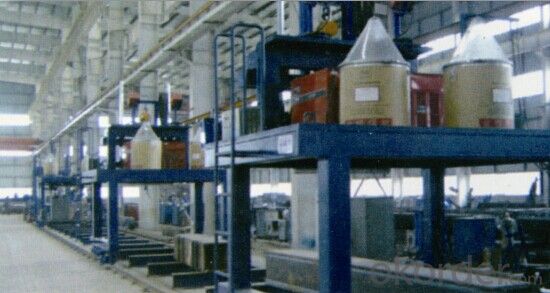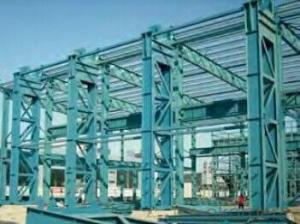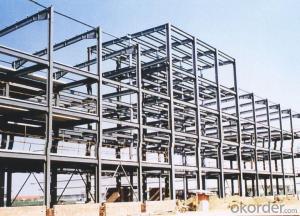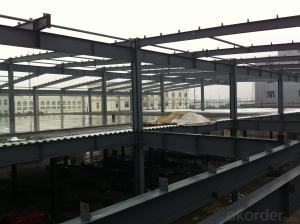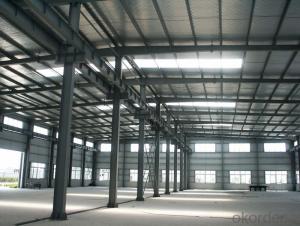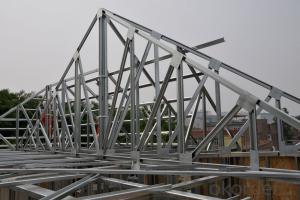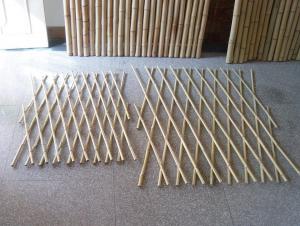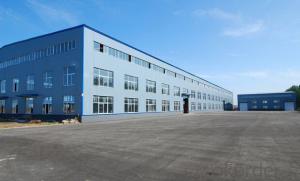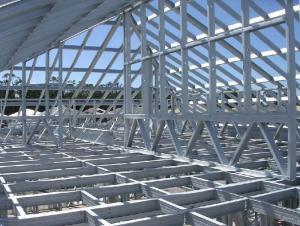Steel Structure with High Quality
- Loading Port:
- China Main Port
- Payment Terms:
- TT OR LC
- Min Order Qty:
- -
- Supply Capability:
- -
OKorder Service Pledge
OKorder Financial Service
You Might Also Like
Steel Structure
Description:
1.Length of the welding withnot indication, full welding should be applied
2.Seam without indication is fillet weld, height is 0.75t
3.The cutting angle without indication, radius R=30
4.Cutting angle not specified should be
5.The diameter of the hole for the bolt if not specified, D=22
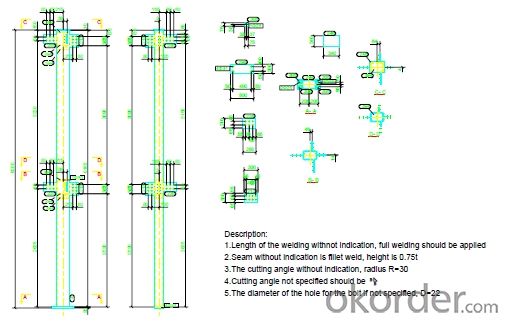
Project Reference:
Taiyuan to Zhongwei (Yinchuan) Railway Yongning Yellow River Grand Bridge Project is a
major project controlled by Ministry of Railways, with total length of 3942.08m, and total weight
of steel structure of 5,200 tons. The main features adopt integral joint structure with required
percentage of perforation of 100%.
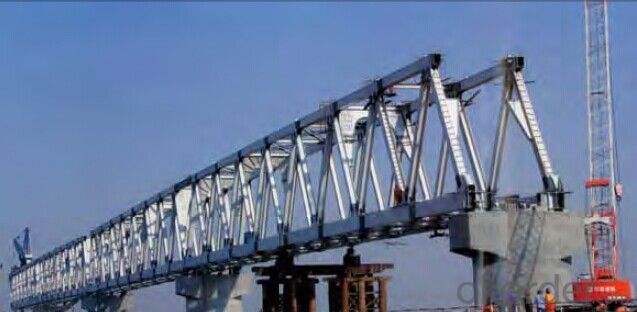
- Q: How are steel structures designed for efficient waste water treatment systems?
- Steel structures are often preferred for constructing efficient waste water treatment systems due to their durability, strength, and versatility. The design of these structures takes into account several factors to ensure efficient waste water treatment. Firstly, the design considers the specific requirements of the waste water treatment process. Different treatment systems have distinct needs, such as the amount of space required for various treatment units, the necessary equipment and machinery, and the flow dynamics within the structure. Steel structures can be easily customized to accommodate these requirements, allowing for optimal performance and efficiency. Another important consideration in the design of steel structures for waste water treatment systems is corrosion resistance. Waste water often contains chemicals and contaminants that can be highly corrosive. To combat this, steel structures can be coated with specialized corrosion-resistant materials, such as galvanized steel or epoxy coatings. These coatings protect the steel from corrosion, extending the life of the structure and minimizing maintenance needs. Additionally, steel structures are designed to be sturdy and stable. Waste water treatment systems involve the handling of large volumes of water and equipment, which can exert significant loads on the structure. Steel's inherent strength allows for the construction of robust frameworks that can withstand these loads without deformation or failure. This structural stability is crucial for the smooth operation of the treatment system and ensures its long-term efficiency. Furthermore, steel structures can be prefabricated off-site, which offers several advantages. Prefabrication allows for faster construction times, reducing project timelines and costs. It also ensures a higher level of quality control as the components are manufactured in controlled factory conditions. This precise manufacturing process guarantees that the steel structure will fit together seamlessly, enhancing the efficiency of the waste water treatment system. Overall, steel structures are designed for efficient waste water treatment systems by considering the specific requirements of the treatment process, incorporating corrosion-resistant coatings, ensuring structural stability, and utilizing prefabrication techniques. These design considerations enable the construction of robust, durable, and efficient waste water treatment systems that effectively remove contaminants and protect the environment.
- Q: How do steel structures perform in terms of thermal comfort and indoor air quality?
- Steel structures generally perform well in terms of thermal comfort and indoor air quality. Steel is a good conductor of heat, which means that steel structures can effectively regulate indoor temperatures and minimize heat transfer. Additionally, steel structures can be designed with insulation materials to further enhance thermal comfort. In terms of indoor air quality, steel structures have advantages as they do not produce volatile organic compounds or emit harmful gases. This helps to maintain a healthy indoor environment. However, it is important to note that the air quality inside any structure is influenced by various factors like ventilation systems, maintenance practices, and occupant behavior, rather than just the material used in construction.
- Q: How are steel structures used in automotive manufacturing plants?
- Steel structures are used extensively in automotive manufacturing plants to provide a strong and durable framework for various operations. They are used for constructing the plant's main building, assembly lines, and storage facilities. Steel structures offer the necessary strength and stability to support heavy machinery, equipment, and vehicles, ensuring a safe working environment for employees. Additionally, steel can be easily customized and modified, allowing for efficient expansion or reconfiguration of the plant as needed. Its corrosion resistance and fireproof properties also contribute to the overall safety and longevity of automotive manufacturing plants.
- Q: How are steel stairs designed and installed?
- Steel stairs are designed and installed by following a systematic process. Firstly, the design phase involves determining the specific requirements, such as the height, width, and angle of the stairs, as well as the location and purpose of installation. Once the design is finalized, detailed drawings and specifications are created. During the fabrication stage, the steel components are manufactured according to the design. This involves cutting, shaping, welding, and finishing the steel to ensure precision and durability. The individual parts are then assembled to form the stairs. The installation process starts with preparing the site and ensuring proper anchoring and support. The steel stairs are then carefully positioned and secured in place, ensuring proper alignment, levelness, and stability. Installation also includes attaching handrails, guardrails, and any additional features required for safety and functionality. Throughout the entire process, adherence to relevant building codes and safety standards is crucial. It is recommended to involve experienced professionals, such as architects, engineers, and skilled construction workers, to ensure a well-designed and properly installed steel staircase.
- Q: How do steel structures provide resistance against blast and impact loads?
- Steel structures provide resistance against blast and impact loads due to their high strength and ductility. The inherent properties of steel, such as its ability to absorb and distribute energy, make it a suitable material for withstanding sudden and intense forces. Additionally, the flexibility of steel allows it to bend and deform under extreme loads, reducing the risk of collapse. Moreover, the use of structural elements like bracing, framing, and reinforcement further enhances the resistance of steel structures against blast and impact loads by providing additional support and stability.
- Q: How are steel structures designed to be resistant to chemical corrosion?
- Various methods and techniques are employed in the design of steel structures to ensure their resistance to chemical corrosion. One primary approach is the utilization of corrosion-resistant alloys or coatings on the steel surface. To begin with, stainless steel, known for its high corrosion resistance, is commonly employed in the construction of steel structures. This alloy contains chromium, which, when exposed to oxygen, forms a passive oxide layer on the surface. This oxide layer acts as a protective barrier, preventing direct contact between the steel and corrosive chemicals. In addition to stainless steel, other corrosion-resistant alloys like galvanized steel can be used. Galvanization involves coating the steel with a layer of zinc, which serves as sacrificial protection by corroding in place of the steel. This sacrificial layer ensures the integrity and corrosion resistance of the steel. Moreover, protective coatings can be applied to the steel structure, acting as a barrier against corrosive chemicals and reducing the risk of corrosion. Common coatings include epoxy, polyurethane, and acrylic coatings, applied in multiple layers for added protection. Design considerations also play a crucial role in achieving corrosion resistance. Proper drainage systems are implemented to prevent the accumulation of water or corrosive substances on the steel surface. Adequate ventilation is provided to facilitate air circulation and prevent moisture buildup, which can lead to corrosion. Regular maintenance and inspection are essential to maintain the corrosion resistance of the steel structure. Promptly addressing any signs of corrosion or damage is necessary to prevent further deterioration. This may involve repairing or recoating affected areas and implementing preventive measures to minimize future corrosion risks. In conclusion, the resistance of steel structures to chemical corrosion is achieved through the use of corrosion-resistant alloys, protective coatings, proper design considerations, and regular maintenance. By implementing these measures, steel structures can endure exposure to corrosive chemicals and retain their structural integrity over time.
- Q: What are the advantages of using steel in prefabricated construction?
- There are several advantages of using steel in prefabricated construction. Firstly, steel is a highly durable material that can withstand extreme weather conditions and natural disasters. It provides excellent structural integrity and stability, ensuring the safety of the building. Secondly, steel is lightweight, making it easier to transport and assemble on-site, saving time and cost. Moreover, steel is a versatile material that allows for flexible design options and customization. It can be easily modified, extended, or dismantled, making it suitable for future expansions or modifications. Additionally, steel is a sustainable and eco-friendly choice as it is recyclable and reduces waste during construction. Overall, the use of steel in prefabricated construction offers enhanced strength, efficiency, design flexibility, and environmental benefits.
- Q: What are the considerations for steel structure design in seismic zones?
- When designing steel structures in seismic zones, several considerations need to be taken into account. Firstly, the structure should be designed to withstand the potential ground shaking and seismic forces that may occur in the area. This involves analyzing the seismic hazard and determining the appropriate design criteria, such as the maximum considered earthquake and the design response spectrum. Secondly, the selection of appropriate materials and construction techniques is crucial. Steel structures are preferred in seismic zones due to their ductility and strength. The steel members should be designed to absorb and dissipate seismic energy, preventing excessive deformation or collapse during an earthquake. Furthermore, the connections between steel members play a vital role in ensuring the overall stability of the structure. Special attention should be given to the design of moment-resisting connections and bracing systems to provide the necessary strength and flexibility for seismic resistance. Lastly, regular inspections and maintenance are essential to ensure the ongoing integrity and safety of the steel structure. Any damages or deterioration should be promptly identified and repaired to maintain its seismic performance. Overall, the considerations for steel structure design in seismic zones include analyzing the seismic hazard, selecting appropriate materials and construction techniques, designing robust connections, and ensuring regular maintenance and inspections for long-term safety.
- Q: How are steel structures designed to resist buckling?
- Steel structures are designed to resist buckling through various design techniques and considerations. One common approach is to provide adequate bracing and reinforcement to prevent the compression members from buckling under load. Additionally, engineers carefully analyze the dimensions and proportions of the structural members to ensure they have sufficient strength and stiffness to resist buckling. The use of proper connections, such as welding or bolting, also plays a crucial role in enhancing the overall stability and resistance to buckling of steel structures.
- Q: How are steel structures used in retail and shopping centers?
- Steel structures are commonly used in retail and shopping centers for their strength, durability, and versatility. They provide the framework for the buildings, allowing for large open spaces, high ceilings, and flexible layouts. Steel structures are ideal for supporting heavy loads and can withstand extreme weather conditions, making them a reliable choice for retail spaces. Additionally, their construction process is faster and more efficient compared to traditional building materials, ensuring quicker completion of projects. Overall, steel structures play a crucial role in creating functional and visually appealing retail and shopping centers.
Send your message to us
Steel Structure with High Quality
- Loading Port:
- China Main Port
- Payment Terms:
- TT OR LC
- Min Order Qty:
- -
- Supply Capability:
- -
OKorder Service Pledge
OKorder Financial Service
Similar products
Hot products
Hot Searches
